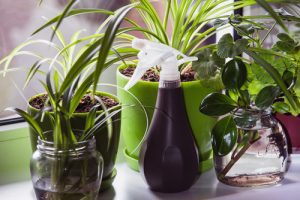Fungus Gnats From Indoor Plants
By Chris Williams on June 17, 2011.
Q. We have these small, dark gnats inside our house. I don’t think they’re fruit flies because I’ve dealt with those before. They sort of look like miniature mosquitoes and they seem to hang around the family room windows. Do you think they’re coming in from outside or are they breeding in my house?
A. There are several different small flies that can become pests inside a home so you really should capture a few and have them identified by an expert. My best guess from your description is that you are dealing with fungus gnats. That doesn’t mean that you have mold growing in your house. In homes, fungus gnats are mostly associated with overwatered house plants. I bet you have some potted plants in your family room near those windows.
Fungus gnat larvae live in the upper layers of soil where they feed on decaying organic material. In some cases, they can damage plant roots. After the larvae are fully developed, adult flies emerge from the soil and fly to lights or windows. The flies can be seen on the surface of the soil or running in a jerky manner across  other surfaces. One way to find out if the gnats are emerging from the plant pots is to cover the soil surface with plastic wrap. Then check for gnats trapped between the plastic and the soil.
other surfaces. One way to find out if the gnats are emerging from the plant pots is to cover the soil surface with plastic wrap. Then check for gnats trapped between the plastic and the soil.
Too much watering and poor pot drainage are the main causes of indoor fungus gnat problems. When the soil in potted plants or large indoor planting beds is kept constantly moist, fungus gnat larvae thrive. So how can you get rid of them? You have to water your plants, you say. Well you don’t have to water them nearly as often as you think. Cut back; stop killing your plants with kindness. The soil doesn’t have to be constantly damp. Letting the soil dry out completely between waterings will kill the fungus gnat larvae. It’s as simple as that; they can’t survive without moist soil.
- Cut back on watering. Let the soil dry completely in between.
- Remove saucers or drain pans underneath plants or empty them after watering so that the water does not sit.
- Discard dead plants, rotting vegetation and infested soil or plants.
- Pot new plants or transplants in fresh potting soil (don’t re-use soil) to avoid introducing fungus gnats.
- Stored unused soil in a covered container so that fungus gnats cannot lay eggs in the mix.
- In extreme or stubborn cases, also add a 1/2-inch layer of sand on top of the soil in pots and plantings. This often deters egg laying by the female fly and keeps the top layer of soil drier.
- If these nonchemical measures don’t work, you can buy an insecticide soil drench that will kill fungus gnat larvae. Make sure fungus gnats are listed on the product label.